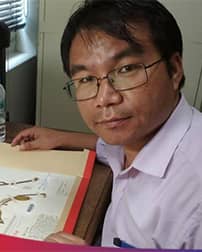AUTHOR GUIDELINES TO THE CONTRIBUTORS
AUTHOR GUIDELINES TO THE CONTRIBUTORS
Published by the Botanical Society of Nepal, Nepal Journal of Botany is the Society’s flagship research journal. The journal publishes original, high-quality, peer-reviewed, innovative research articles of interest to a broad audience of scientists in all areas of plant science. The topics covered by the journal include, but not limited to, biodiversity, systematics, ecology, economic botany, physiology, paleobotany, biotechnology, biochemistry, genetics, plant-microbe interactions, evolution, etc. and focusing all plant groups and allied organisms (e.g., algae, fungi, and lichens). The journal publishes primary research articles as well as review articles, focused on a central theme of interest to all the scientists in plant science. Nepal Journal of Botany welcomes research articles with novel results and new perspectives on topics of interest to the national and international community of plant scientists. Review articles are generally invited and the author(s) should get prior consent from the editors before submitting such articles.
PREPARATION
PREPARATION OF MANUSCRIPTS
For manuscript files, MS Word (.doc) format is preferred. Include all parts of the text of the paper in a single file. Use double-spaces, continuous pagination and line numbering throughout the manuscript, to facilitate review commenting. Leave at least a 2.5-cm margin on all sides. Number figures and tables in the order discussed in the text. Plants must be defined by taxonomic names and authority. The cover page should include Title of the article, Abstract and Key words. All authors of a manuscript should include their full names, affiliations (not position) and email addresses on the cover page of the manuscript. One author should be identified as the corresponding author. The corresponding author must be authorized by all co-authors to act as an agent on their behalf in all matters pertaining to publication of the manuscript, and the order of names should be agreed by all authors. Acknowledgements should briefly give credit to other people who have made a contribution to the study, and list the relevant grants that funded the study. The manuscript should be divided into the following sections in general: Abstract, Introduction, Materials and Methods, Results, Discussion, Acknowledgements, References, Tables, Figures, Appendices.
Tables and figures should appear after the main text. Captions should appear with their respective table or figure. Footnotes for tables should be given below the table. The tables must be as simple as possible, with few horizontal and, preferably, no vertical rules. The photographs should be grouped into one or more plates.
Essential title page information
• Title. Concise and informative. Titles are often used in information-retrieval systems. Avoid abbreviations and formulae where possible.
• Author names and affiliations. Please clearly indicate the given name(s) and family name(s) of each author and check that all names are accurately spelled. Present the authors' affiliation addresses (where the actual work was done) below the names. Indicate all affiliations with a lower-case superscript letter immediately after the author's name and in front of the appropriate address. Provide the full postal address of each affiliation, including the country name and, if available, the e-mail address of each author. Do not provide position.
• Corresponding author. Clearly indicate who will handle correspondence at all stages of refereeing and publication, also post-publication. This responsibility includes answering any future queries about Methodology and Materials. Ensure that the e-mail address is given and that contact details are kept up to date by the corresponding author.
Abstract
The Abstract comes after the title page in the manuscript file. The abstract text is also entered in a separate field in the submission system.
The Abstract should:
- Not exceed 250 words
- Describe the main objective(s) of the study
- Explain how the study was done, including any model organisms used, without methodological detail
- Summarize the most important results and their significance
Abstracts should not include:
- Citations
- Abbreviations, if possible
Keywords
Provide a maximum of 6 keywords, avoiding general and plural terms and multiple concepts (avoid, for example, 'and', 'of'). Be sparing with abbreviations: only abbreviations firmly established in the field may be eligible. These keywords will be used for indexing purposes.
Abbreviations
Define abbreviations that are not standard in this field in a footnote to be placed on the first page of the article. Such abbreviations that are unavoidable in the abstract must be defined at their first mention there, as well as in the footnote. Ensure consistency of abbreviations throughout the article.
Author abbreviation should follow International Plant Names Index, and Index Fungorum, Authors of Fungal names. Herbarium abbreviation should follow Index herbariorum. Journal abbreviation should follow BPH online.
Article structure
Subdivision - numbered sections
Divide article into clearly defined and numbered sections e.g., 1 Introduction; 2 Material and methods and so on. Subsections should be numbered 1.1 (then 1.1.1, 1.1.2, ...), 1.2, and so on. (the abstract is not included in section numbering). Use this numbering also for internal cross-referencing. Any subsection may be given a short heading.
Introduction
Provide an adequate background and clearly state the objectives of the work. Include literature survey but avoid a detailed literature survey and a summary of the results.
Material and methods
Provide sufficient details to allow the work to be reproduced by an independent researcher. Methods that are already published should be summarized, and indicated by a reference. If quoting directly from a previously published method, use quotation marks and also cite the source. Any modifications to existing methods should also be described.
Theory/calculation (optional)
A Theory section should extend, not repeat, the background to the article already dealt with in the Introduction and lay the foundation for further work. In contrast, a Calculation section represents a practical development from a theoretical basis.
Results
Results should be clear and concise.
Discussion
This should explore the significance of the results of the work, not repeat them. Avoid extensive citations and discussion of published literature.
Conclusions
The main conclusions of the study may be presented in a short Conclusions section, which may stand alone or form a subsection of a Discussion or Results and Discussion section.
Acknowledgements
Collate acknowledgements in a separate section at the end of the article before the references and do not include them on the title page, as a footnote to the title or otherwise. List here those individuals who provided help during the research (e.g., providing language help, writing assistance or proof reading the article, etc.).
Appendices
If there is more than one appendix, they should be identified as A, B, etc. Formulae and equations in appendices should be given separate numbering: Eq. (A.1), Eq. (A.2), etc.; in a subsequent appendix, Eq. (B.1) and so on. Similarly for tables and figures: Table A.1; Fig. A.1, etc.
Nomenclature and units
Follow internationally accepted rules and conventions: use the international system of units (SI). If other quantities are mentioned, give their equivalent in SI. Consult IUPAC: Nomenclature of Organic Chemistry for further information.
Math formulae
Please submit math equations as editable text and not as images. Present simple formulae in line with normal text where possible and use the solidus (/) instead of a horizontal line for small fractional terms, e.g., X/Y. In principle, variables are to be presented in italics. Powers of e are often more conveniently denoted by exp. Number consecutively any equations that have to be displayed separately from the text (if referred to explicitly in the text).
Taxonomic account
Scientific name of the organism should be written in the bold followed by author citation (follow IPNI: https://ipni.org). Homotypic synonyms should be grouped in chronological order after the accepted name followed by heterotypic synonym.
The herbarium in which the holotype is deposited should be cited followed by the herbaria which hold isotypes. For new taxa, all the materials seen and examined should be cited.
Footnotes
Footnotes should be used sparingly. Number them consecutively throughout the article, using superscript Arabic numbers. Do not include footnotes in the Reference list.
Table footnotes
Indicate each footnote in a table with a superscript lowercase letter.
Figures
Do not include figures in the main manuscript file. Each figure must be prepared and submitted as an individual file.
Cite figures in ascending numeric order at first appearance in the manuscript file.
Figure captions must be inserted in the text of the manuscript, immediately following the paragraph in which the figure is first cited (read order). Do not include captions as part of the figure files themselves or submit them in a separate document.
At a minimum, include the following figure captions:
A figure label with Arabic numerals, and “Figure” abbreviated to “Fig” (e.g. Fig 1, Fig 2, Fig 3, etc). Match the label of figure with the name of the file uploaded at submission (e.g. a figure citation of “Fig 1” must refer to a figure file named “Fig1.jpeg”).
A concise, descriptive title
The caption may also include a legend as needed.
General points
• Make sure to use uniform lettering and sizing of the original artwork.
• Embed the used fonts if the application provides that option.
• Aim to use the following fonts in the illustrations: Arial, Courier, Times New Roman, Symbol, or use fonts that look similar.
• Number the illustrations according to their sequence in the text.
• Use a logical naming convention for artwork files.
• Provide captions to illustrations separately.
• Size the illustrations close to the desired dimensions of the published version.
• Submit each illustration as a separate file.
• Ensure that color images are accessible to all, including those with impaired color vision.
Please convert the images to one of the following formats (note the resolution requirements for line drawings, halftones, and line/halftone combinations given below):
EPS (or PDF): Vector drawings, embed all used fonts.
TIFF (or JPEG): Color or grayscale photographs (halftones), keep to a minimum of 300 dpi.
Please do not:
• Supply files that are optimized for screen use (e.g., GIF, BMP, PICT, WPG, Bitmapped); these typically have a low number of pixels and limited set of colors;
• Supply files that are too low in resolution;
• Submit graphics that are disproportionately large for the content.
Color artwork
Please make sure that artwork files are in an acceptable format (TIFF (or JPEG), EPS (or PDF)) and with the correct resolution.
Tables
Number tables consecutively in accordance with their appearance in the text. Place footnotes to tables below the table body and indicate them with superscript lowercase letters. Avoid vertical rules. Be sparing in the use of tables and ensure that the data presented in tables do not duplicate results described elsewhere in the article.
References
Citation in text
Please ensure that every reference cited in the text is also present in the reference list (and vice versa). Unpublished results and personal communications are not recommended in the reference list, but may be mentioned in the text. If these references are included in the reference list, they should follow the standard reference style of the journal and should include a substitution of the publication date with either 'Unpublished results' or 'Personal communication'. Citation of a reference as 'in press' implies that the item has been accepted for publication.
Web references
As a minimum, the full URL should be given and the date when the reference was last accessed. Any further information, if known (DOI, author names, dates, reference to a source publication, etc.), should also be given. Web references can be listed separately (e.g., after the reference list) under a different heading if desired, or can be included in the reference list.
Reference Style
The Journal uses “Vancouver” style. References should be listed according to the examples below:
Research paper:
Ranjitkar S, Sujakhu NM, Jati R, Xu J, Schmidt-Vogt D. Yield and household consumption of Rhododendron arboreum as a fuelwood species in Eastern Nepal. Biomass and Bioenergy. 2014;61:245–53. http://dx.doi.org/10.1016/j.biombioe.2013.12.016,
Book:
Barnekow Lillesø J, Shrestha T, Dhakal L, Nayaju R, Shrestha R. The Map of Potential Vegetation of Nepal. Development and Environment. 2005. 24 p.
Book section:
Kassam K-AS, Graham J. Indigenous knowledge, community participation and traditional land-use mapping. In: Sellick M, Delaney R, Brownlee K, editors. Social Work with Rural and Northern Communities. Thunder Head Bay, ON: Lakehead University, Centre for Northern Studies; 1999. p. 192–212.
Conference Proceedings:
Hanif M, Bari M, Rahman MA. Potentiality of agroforestry species to climate change mitigation through carbon sequestration. In: Proceedings of 5th International Conference on Environmental Aspects of Bangladesh. 2014. p. 24–6.
Thesis:
Kafle S. Agroforestry system and their carbon stock in terai and mid-hill regions of Central Nepal. Central Department of Botany, Tribhuvan University, Kirtipur; 2015. http://107.170.122.150:8080/xmlui/handle/123456789/326
Computer program:
Kindt R. BiodiversityR: GUI for biodiversity, suitability and community ecology analysis. http://cran.r-project.org/web/packages/BiodiversityR/; 2014. http://www.worldagroforestry.org/output/tree-diversity-analysis
Research Data
This journal encourages to share data that supports the research publication where appropriate, and enables to interlink the data with the published articles. Research data refers to the results of observations or experimentation that validate research findings. To facilitate reproducibility and data reuse, this journal also encourages to share software, code, models, algorithms, protocols, methods and other useful materials related to the project.
Peer review
This journal operates a single anonymized review process. All contributions will be initially assessed by the editor for suitability for the journal. Papers deemed suitable are then typically sent to a minimum of two independent expert reviewers to assess the scientific quality of the paper. The Editor is responsible for the final decision regarding acceptance or rejection of articles. The Editor's decision is final. Editors are not involved in decisions about papers which they have written themselves or have been written by family members or colleagues or which relate to products or services in which the editor has an interest. Any such submission is subject to all of the journal's usual procedures, with peer review handled independently of the relevant editor.
AFTER ACCEPTANCE
Proofs
One set of page proofs (as PDF files) will be sent by e-mail to the corresponding author or a link will be provided in the e-mail so that authors can download the files themselves. To ensure a fast publication process of the article, we kindly ask authors to provide us with their proof corrections within two days.
Please use this proof only for checking the typesetting, editing, completeness and correctness of the text, tables and figures. Significant changes to the article as accepted for publication will only be considered at this stage with permission from the Editor. We will do everything possible to get the article published quickly and accurately. It is important to ensure that all corrections are sent back to us in one communication: please check carefully before replying, as inclusion of any subsequent corrections cannot be guaranteed. Proofreading is solely authors responsibility.












